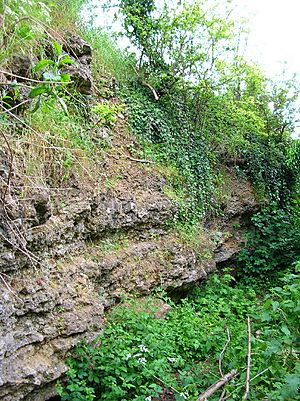Rock Edge facts for kids
| Site of Special Scientific Interest | |
 |
|
| Area of Search | Oxfordshire |
|---|---|
| Interest | Geological |
| Area | 1.7 hectares (4.2 acres) |
| Notification | 1986 |
| Location map | Magic Map |
Rock Edge is a very special place in Oxford, Oxfordshire, England. It's a small area, about the size of two football fields, that is protected because of its amazing rocks and fossils. It's known as a Site of Special Scientific Interest (SSSI) and a Local Nature Reserve.
What Makes Rock Edge Special?
Rock Edge is famous for its rocks, which tell a story from millions of years ago. These rocks are a type of limestone called coral rag. Imagine a time when Oxford was covered by a warm, shallow sea. This sea was much like the sunny Bahama Banks are today. The coral rag formed from ancient coral reefs that grew in that sea.
Because of these old reefs, Rock Edge is full of fossils. These are the preserved remains of sea creatures that lived there long ago. Scientists can study these fossils to learn about Earth's past.
A Journey Back in Time
The rocks at Rock Edge date back to the Upper Jurassic period. This was about 145 million years ago! To give you an idea, this was a time when huge dinosaurs like the Stegosaurus and Brachiosaurus roamed the land. Under the sea, where Oxford is now, corals were building reefs.
The fossils found here include parts of corals, shells, and other sea life. They show us what the ancient sea looked like. It's like a window into a prehistoric ocean world.
Why is it Protected?
Rock Edge is protected for a few important reasons:
- Site of Special Scientific Interest (SSSI): This means it's one of the best places in the country for its natural features. In this case, it's for its geology and fossils.
- Geological Conservation Review site: This is a list of places that are important for understanding Earth's history. Rock Edge helps us learn about ancient seas and climates.
- Local Nature Reserve: This means it's a place where local people can enjoy nature. It's also a place where wildlife can thrive.
Protecting Rock Edge helps scientists study the past. It also lets students and visitors see these amazing rocks and fossils for themselves. It's a great spot to learn about geology and Earth's long history.

